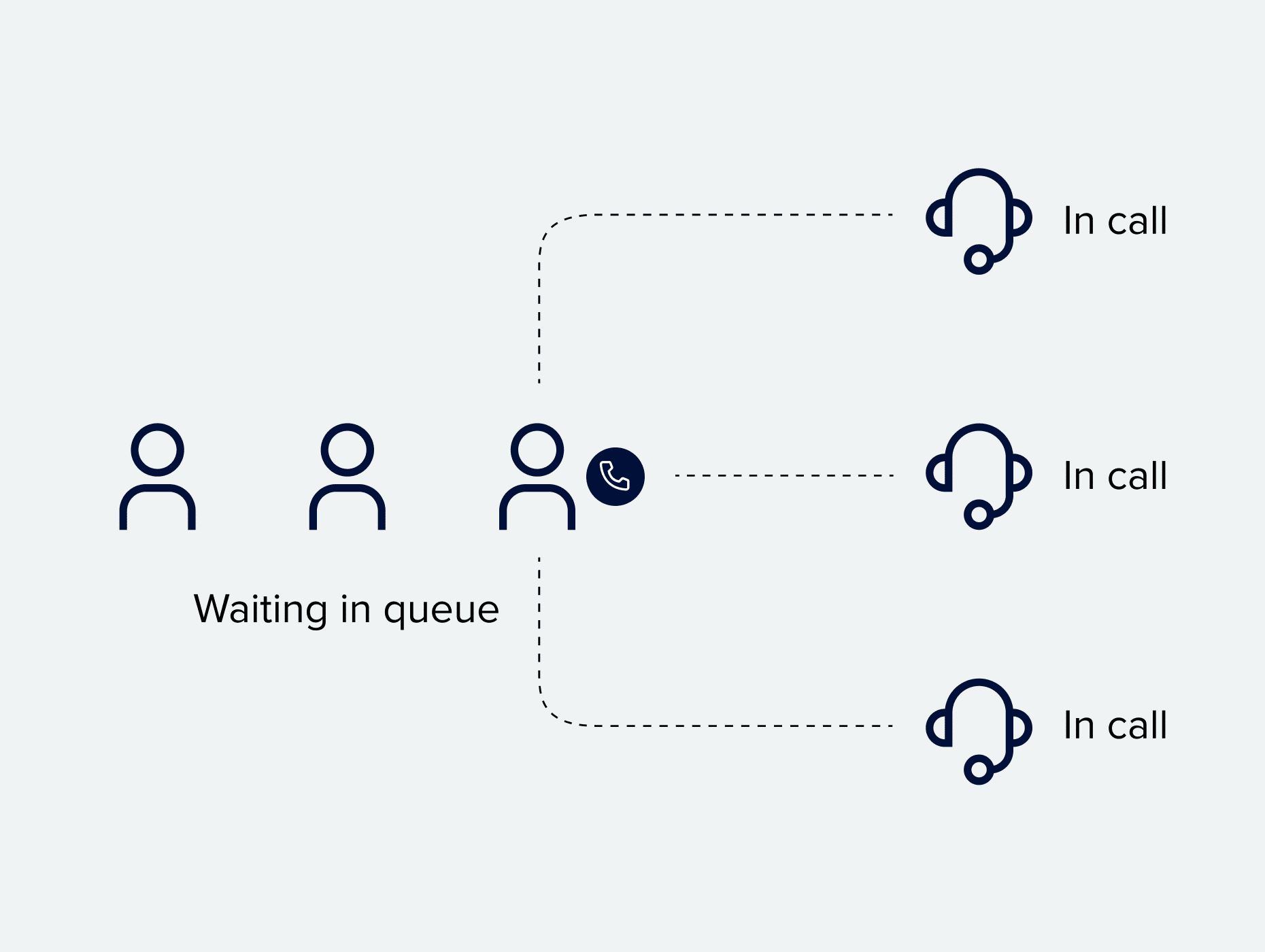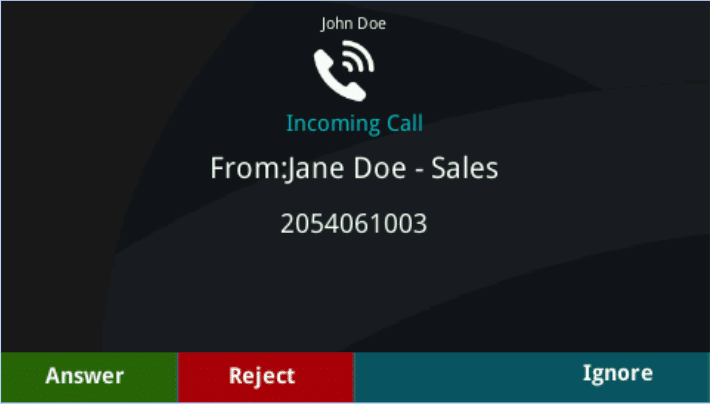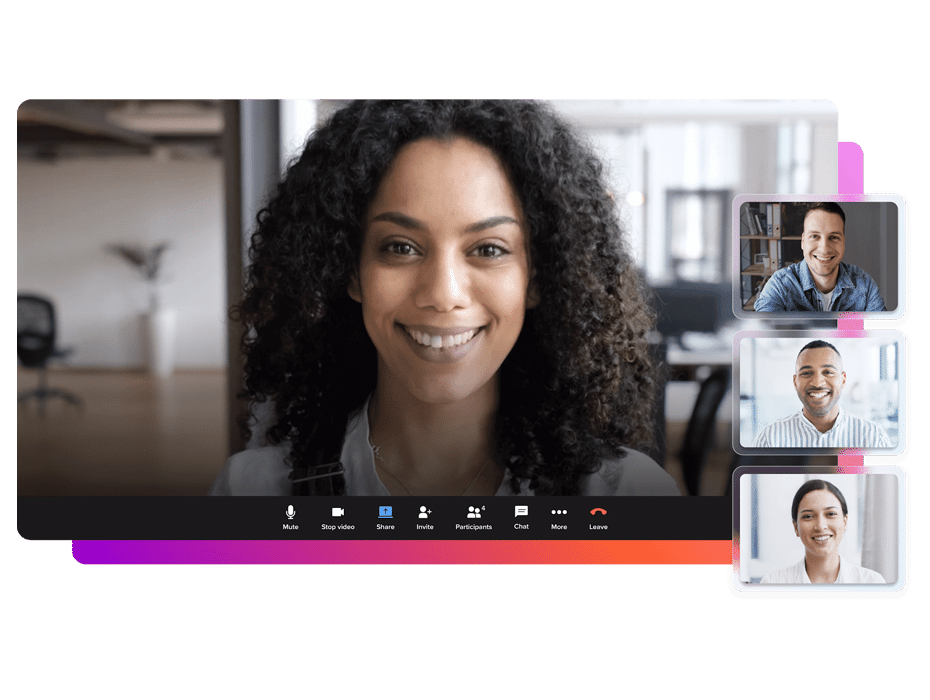Customers have high expectations for the businesses they interact with. That includes connecting with call center representatives as quickly as possible.. After all, calling is still the number one channel (71%) customers prefer for reaching a company. The less they wait on hold for call agents, the happier they’ll be.
So how can businesses reduce the amount of time their customers wait on the phone, especially when phone lines get congested? That’s where call queues come in.
- What is a call queue?
- Why should I use call queues?
- When should I use call queues? How many call queues do I need?
- How do I personalize my call queue in RingCentral?
- How do call queues benefit your business?
What is a call queue?
A call queue distributes calls to employees in your organization who can help resolve an issue or answer a question.
For example, when a customer service call is received, the caller is typically greeted by a welcome message and connected to an available employee (“agent”). If no agents are available, the caller is “queued,” hearing music and/or a message.
The caller waiting is connected automatically to the next available agent. Calls not answered after a configurable wait time may be routed to an alternate destination (answering service or voicemail box). Voicemail transcription provides call queue managers with text-based call notifications when callers leave a message, so they can call back customers when call center agents are available.

A call queue consists of:
- Schedule: Your schedule specifies how calls are handled when the business is open and closed, including holidays and weekends.
- Greetings and music: Upload custom recorded messages and audio files or choose from a library of pre-recorded greetings and hold music to tailor the caller’s experience while waiting for an agent.
- Call distribution: Inbound calls are distributed to call agents using a “first-in, first-out” strategy. The first call received is the first call connected to an available agent.
- Routing method: The next available agent is selected to receive calls using any of these methods: rotating (or most idle agent), sequential (or top-down), or simultaneous.
- Call handling and routing options: These advanced call options allow you to send callers to other call queues, users, IVR menus, or external numbers when different conditions occur (for example, if the wait time is greater than one minute).
- Reports: Real-time and historical call analytics help managers monitor the callers’ experiences (e.g., amount of time on waiting on hold, service level delivered) and agent performance (e.g., number of calls answered).

Why should I use call queues?
- Reduce the amount of time calls are waiting: Call queues help route callers to the appropriate agent. That means fewer transfers between agents and more time resolving issues.
- Flexible call flows: Call queues allow you to route calls to call center agents, extensions, or external numbers based on a schedule (open, closed, or holiday) or when certain conditions occur (such as wait time is greater than one minute, more than 10 callers are waiting in the queue, no agents are available, etc.).
- Improve the customer experience with data: Call queues capture data that gives managers deep insights into the customer experience such as wait time, talk time, hold time, and more.
- Improve agent performance: Call queues also provide reports on agent productivity (e.g., number of calls answered, which agents placed calls on hold, etc.). Call queue reports can help determine when additional staff or schedule changes are needed during busy times.
😃 😠 😣 Your first chance to make a good impression is your only chance to make an impression 😃 😠 😣
1/3 of your customers will leave after just one bad experience! See how RingCentral contact center helped these 6 companies better serve their customers
When should I use call queues? How many call queues do I need?
Different types of calls require different expertise. You might need a Customer Service call queue for a team of employees who answer calls related to purchasing a product; or, a Help Desk call queue for a team of IT employees who resolve technical issues.
To help determine how many call queues you may need:
- Create a list of the types of incoming calls that need to be answered.
- Consider the reporting data you’ll need.
Each call queue report includes several key performance metrics (KPIs) that help the business monitor the customer experience while measuring agent productivity. If you plan to answer different types of calls with a single call queue, the report will show summarized call information. For example, if you answer Apartment Sales and Home Sales calls using one Sales call queue, the report will show both call types together (e.g. sales calls=10)
If you plan to answer each inbound call type with a unique call queue, the report will show individual call type data. For example, if Apartment Sales and Home Sales call types are answered by their own unique call queues, each report will show individualized data (apartment sales calls=8; home sales calls=2).
Once you’ve created a list of incoming calls you need to answer and grouped them together (or separately) based on the reporting you need, you’re ready to set up your call queue(s).
How do I personalize my call queue in RingCentral?
To create a call queue, log in to the Admin Portal, navigate to Phone System > Groups > Call Queues, and click New Call Queue. For each call queue:
- Configure the call queue details: name, extension, and site.
- Select the call queue manager(s) and permission(s). Full-access managers may change all call queue settings, while member management managers may add/remove agents.
- Select the call queue agents who will answer calls.
Once the call queue is created, you can personalize these additional settings:
- Schedule: The call queue schedule is set to “Open 24 hours/7 days a week” by default. To configure different hours, select the desired call queue, navigate to Call Queue Details > Settings, and select Custom hours.
- Direct Numbers: Add one or more (optional) toll-free or local phone numbers that will be answered by the call queue. Alternatively, you may first answer the call using an auto-attendant or IVR menu that routes the caller to the call queue based on the caller’s response to prompts (e.g., “Press 1 for Sales, press 2 for Support).
- Greeting & Hold Music: Greetings are optional recorded messages that are played to callers at different times during the call. You can upload custom greetings and audio files or select from a library of pre-recorded options.
- Call Queue Greeting: This optional welcome announcement is played to callers before being connected to an agent.
- Audio While Connecting: Music on hold is played to callers while they’re “queued” waiting to be connected to the next available agent.
- Interrupt Audio: This optional announcement is played periodically while the caller is waiting to be connected to an agent, e.g., “Thanks for your patience; we will answer your call shortly.”
- Hold Music: The music callers will hear if the agent places the call on hold.
-
- Call Handling & Members: Agent selection, routing method, and wait settings determine the call flow, e.g., how calls are answered and the caller’s experience while waiting to be connected.
-
- Business Hours: These settings control how agents in the queue are selected to receive calls when the call queue is open.
- Wait Settings: These advanced call settings control how calls are routed when different call queue conditions occur:
- Maximum number of callers allowed in queue
- How should calls be routed when the queue is full?
- Maximum wait time in queue
- How should calls be routed when maximum wait time is reached?
- How should calls be routed when agents are available but do not answer or when all agents are busy or unavailable?
- Display Settings: These settings determine the call information displayed to the agent while the call is ringing/connected (e.g., Call Queue Name, Caller ID Name, and Caller ID Number).

Incoming queue call information on Polycom phone
- After Hours: Specifies how calls are routed when the call queue is closed.
- Custom Rules: Configure a custom rule to route calls during holidays.
- Messages & Notifications: Voicemail box greeting and message notification settings.
How do call queues benefit your business?

1. A more personalized experience for customers
The best calling experience resolves an issue quickly, and that means routing calls to the appropriate call center agents. For example, before callers get connected to an agent, they navigate through the business phone system’s IVR to determine their concern.
By the time they reach an agent, the agent already has some background info on the caller (account info, purchase history, and or support issue) and can start the resolution cycle immediately.
2. Reduce wait times and abandon rates
Without an efficient call management system, customers can spend excess amounts of time waiting on hold or speaking to the wrong representative.
A call queue distributes calls to the right agents to resolve issues faster. That means shorter wait times for customers waiting in line and lower abandon rates overall.
3. Optimize costs and efficiency
As the old saying goes: time is money. The less time agents spend on issues, the lower your cost per call.
With call queues, the entire resolution cycle is streamlined, allowing your agents to make the most of every call and churn through customers faster.
4. Workforce engagement
Working with customers all day (many of whom dial in frustrated) is an exhausting job. Call queues, however, make their work much easier by reducing the tension in calls and empowering them to resolve issues quickly.
Deliver the service your customers deserve
Whether your business’s call volume is growing or already has call center software, call queuing ensures that your teams have the tools to provide exceptional service and win the loyalty of your customers.
Originally published Feb 03, 2021, updated Jun 20, 2024





